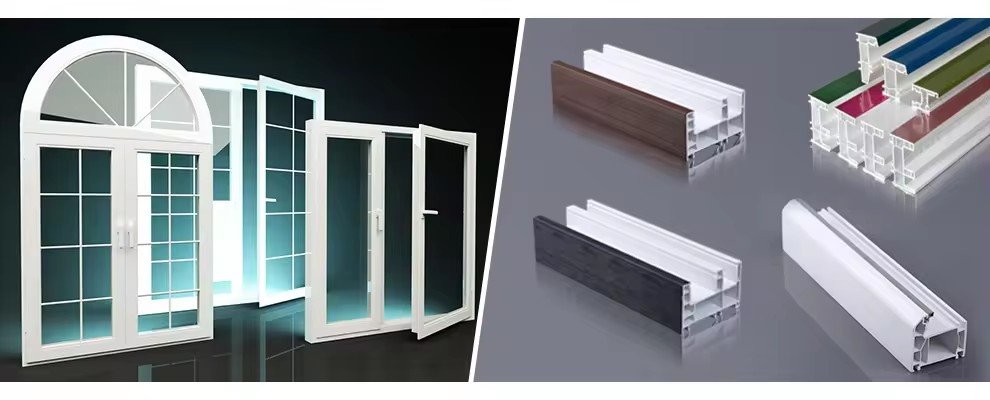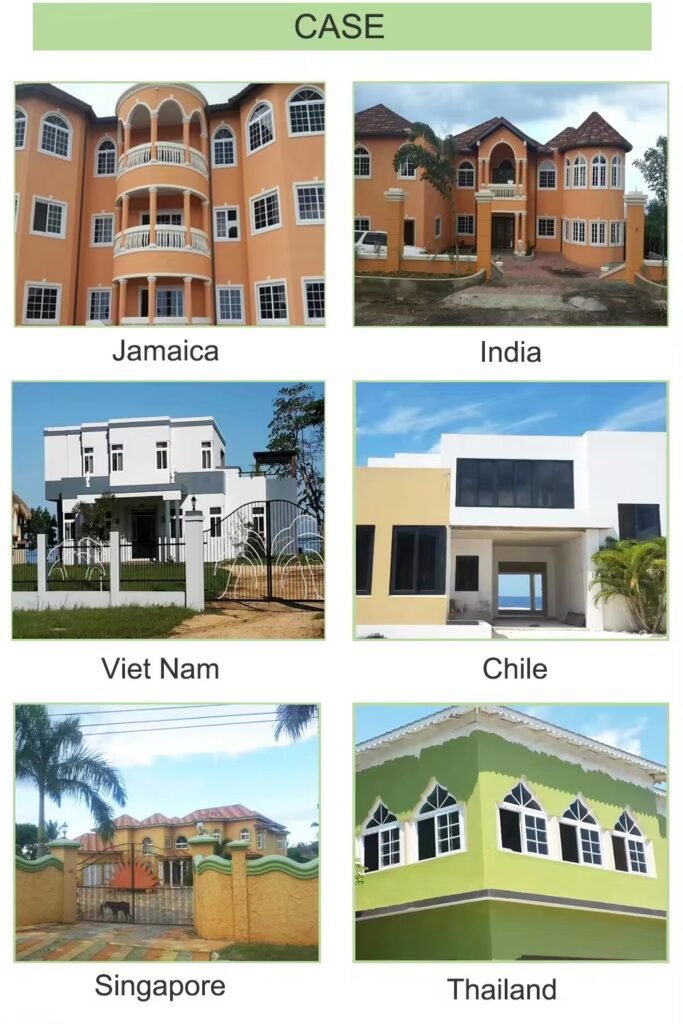UPVC profiles are available in a variety of colors and formulations to meet diverse aesthetic preferences, performance requirements, and environmental considerations. Here are some common color options and formula systems used in UPVC profiles:
- Standard White UPVC Profiles
- Full-Body Colored UPVC Profiles
- Woodgrain Effect UPVC Profiles
- Metallic Finish UPVC Profiles
- Custom Colors and Formulations
These formulation systems may include additives such as UV stabilizers, impact modifiers, heat stabilizers, flame retardants, and biocides to meet industry standards and regulatory requirements while achieving desired performance goals.

Do white upvc profiles perform better than full-body colored profiles?
The performance of white profiles versus full-body colored profiles depends on various factors such as the materials used, manufacturing processes, and environmental conditions. Here are some considerations:
1. Solar Heat Absorption: White profiles typically reflect more solar heat compared to colored profiles, which absorb heat. In regions with hot climates, white profiles may help keep interiors cooler by reducing heat transfer through windows and doors. However, in colder climates, the additional solar heat absorption of colored profiles might be beneficial for passive heating during winter.
2. Thermal Expansion: Colored profiles, especially dark colors, may absorb more heat from sunlight, leading to greater thermal expansion. This expansion can affect the dimensional stability of the profiles over time, potentially causing warping or distortion. White profiles, with their higher reflectivity, may experience less thermal expansion and contraction, contributing to better long-term performance.
3. UV Resistance: White profiles often contain additives or coatings to enhance UV resistance and prevent yellowing or degradation from prolonged exposure to sunlight. Colored profiles may also have UV-resistant properties, but the effectiveness can vary depending on the pigments and additives used in the coloring process. Proper UV protection is essential for maintaining the appearance and structural integrity of both white and colored profiles.
4. Aesthetic Considerations: The choice between white and colored profiles may also depend on aesthetic preferences and architectural design requirements. White profiles offer a clean, classic look that complements many building styles and color schemes. On the other hand, colored profiles provide opportunities for customization and can enhance the visual appeal of a building façade or interior space.
5. Manufacturing Quality: The performance of both white and colored profiles ultimately depends on the quality of materials and manufacturing processes. High-quality profiles, regardless of color, should meet industry standards for strength, durability, weather resistance, and thermal performance. Proper installation and maintenance are also critical factors in ensuring optimal performance and longevity.
In summary, while white profiles may offer advantages in terms of solar heat reflection, thermal stability, and UV resistance, the choice between white and colored profiles should consider specific project requirements, regional climate conditions, aesthetic preferences, and quality considerations. Ultimately, both types of profiles can perform well when manufactured and installed correctly.

Which formula technology is more advanced, white upvc profiles or full-body colored profiles?
Both white profiles and full-body colored profiles can utilize advanced formulation technologies to achieve desired performance characteristics. The choice between them depends on specific application requirements, aesthetic preferences, and technological advancements in the industry. Here’s a comparison:
White Profiles
- Advanced formulation technologies for white profiles often focus on enhancing properties such as UV resistance, weatherability, thermal stability, and energy efficiency.
- Formulations may include additives such as UV stabilizers, heat stabilizers, impact modifiers, and thermal insulators to improve performance and durability.
- White profiles are typically designed to reflect solar heat and maintain a clean, bright appearance over time.
- Advanced manufacturing techniques, such as co-extrusion or multi-layer construction, may be used to incorporate different materials or additives into the profile for optimized performance.
Full-Body Colored Profiles
- Advanced formulation technologies for full-body colored profiles aim to achieve consistent coloration, improved colorfastness, and enhanced durability.
- Pigments and additives are carefully selected to ensure uniform color distribution, resistance to fading, and long-term color retention, even in harsh environmental conditions.
- Advanced coloring processes, such as compounding, extrusion, or surface treatments, may be employed to achieve vibrant, long-lasting colors.
- Formulations may also include additives to enhance properties like UV resistance, impact strength, and scratch resistance, while maintaining color integrity.
In terms of technological advancements, both white profiles and full-body colored profiles benefit from ongoing research and innovation in materials science, polymer chemistry, and manufacturing processes. Lanke continuously strive to develop new formulations, additives, and processing techniques to improve the performance, aesthetics, and sustainability of PVC profiles.
Ultimately, the choice between white profiles and full-body colored profiles depends on project requirements, design preferences, and specific performance criteria. Both options can leverage advanced formulation technologies to meet the demands of modern construction and architectural applications.

Future development of Lanke UPVC profile colors and formulas
The future development of UPVC profile colors and formulas is likely to focus on several key areas to meet evolving market demands, regulatory requirements, and sustainability goals. Here are some potential trends and advancements to expect:
1. Expanded Color Options: Lanke manufacturer introduce a broader range of colors and finishes to offer more design flexibility and customization options for architects, builders, and homeowners. This could include trendy colors, woodgrain finishes, metallic effects, and textured surfaces to mimic natural materials or achieve specific aesthetic preferences.
2. Enhanced Colorfastness: Continued research and development efforts will focus on improving the colorfastness and long-term durability of UPVC profiles, especially for full-body colored profiles. Advanced pigment technologies, UV stabilizers, and surface treatments may be utilized to ensure colors remain vibrant and resistant to fading, even in harsh environmental conditions.
3. Sustainable Formulations: With increasing emphasis on sustainability and environmental responsibility, future UPVC profile formulas prioritize the use of eco-friendly materials, renewable resources, and recyclable additives. Bio-based additives, recycled content, and closed-loop manufacturing processes could become more prevalent to reduce environmental impact and promote circularity in the industry.
4. Energy-Efficient Profiles: Energy efficiency will remain a critical consideration in building design and construction. Future UPVC profile formulas may incorporate advanced insulating materials, thermal barriers, and low-emissivity coatings to enhance energy performance and contribute to sustainable building practices. These profiles can help reduce heating and cooling costs while improving occupant comfort and building energy ratings.
5. Smart Materials and Technologies: As smart building technologies continue to advance, UPVC profiles integrate innovative features such as embedded sensors, self-cleaning surfaces, or responsive coatings to enhance functionality and performance. These smart materials can help optimize building operations, enhance security, and improve overall occupant experience.
6. Regulatory Compliance and Health Standards: We will continue to ensure that UPVC profile formulas comply with stringent regulatory standards and health guidelines, including restrictions on hazardous substances and emissions. Efforts to minimize VOCs (volatile organic compounds), phthalates, and other potentially harmful chemicals will remain a priority to ensure product safety and environmental sustainability.
7. Digital Design and Manufacturing: Advancements in digital design tools, simulation software, and additive manufacturing techniques revolutionize the development and production of UPVC profiles. Digital twins, virtual prototyping, and 3D printing technologies could streamline product development processes, reduce time to market, and enable more complex geometries and customization options.
8. Global Market Trends: Our Lanke will closely monitor global market trends, consumer preferences, and regional requirements to tailor UPVC profile colors and formulas to specific markets and applications. This may involve collaboration with architects, designers, and industry stakeholders to anticipate emerging trends and address evolving needs in different sectors, such as residential construction, commercial buildings, and infrastructure projects.
Overall, the future development of Lanke UPVC profile colors and formulas will be driven by a combination of technological innovation, sustainability goals, market demands, and regulatory considerations. By embracing these trends and advancements, we can continue to deliver high-performance, aesthetically pleasing, and environmentally responsible solutions for the built environment.

